Dairy products typical of Polish cuisine — cream, cheese, twarog, eggs
Cream and yoghurt
Cream – both sour and fresh – plays a significant role in the Polish cuisine since ever. Everywhere there, where in the Balkan or oriental cuisine a yoghurt appears, in Poland we come across the cream. Therefore the cream usually constitutes the base of sauces, soups and some pickles. In spite of the great tradition in cream production and sour milk manufacturing, the Balkan yoghurt wasn't practiced in Polish cuisine till modern times.
On the other side eating Tartar kefir has been accepted and became widespread much earlier. Nowadays the situation looks totally different – shelves of stores bend under dairy products of all types, so as yoghurts, buttermilk and kefir. However all of them stays considered as desserts, or simply healthy additions to the everyday diet. They are not treated by the Polish cuisine as ingredients of meals. In this issue cream preserved a dominating role with ease and in the unswerving way.
Cheeses
Apart from eggs, in modern and Old Polish cuisine a cow's curd cheese (twaróg aka "white cheese") is next consequential dairy product. Its meaning and popularity are comparable to the role that feta cheese plays in Balkans and Near East. On the other hand sheep's dairy products are known very well in Polish mountains (Tatra Mountains), where senior shepherds produce smoked ewe's milk cheese called 'oscypek' and some other kinds of salty, sheep's milk cheeses. Thanks to a unique taste and the tradition background – all of them constitute an essential tourist attraction, both for passengers from foreign countries, as well as for Poles coming from lowland to Tatra Mountains for hiking or skiing.
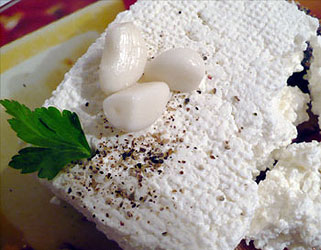
We should add that in contrast with curd cheeses, hard cheeses don't constitute the Polish tradition and they appeared in Poland only after spreading of rennet technology. Nevertheless hard cheeses belong to basic dairy products in Poland – just like they do in many other countries. Hard cheeses are not, however, elements of Polish dishes – just like in the case of yoghurts vs cream. They are eaten in the form of sandwiches (both cold and hot), that are extremely popular; as well as in extraneous dishes from other countries. Selection of yellow cheeses in Polish stores is definitely larger, than of curd and cottage cheeses. That is because of their great popularity, great significance in the ordinary, everyday, nontime-consuming 'menu' and on account of wide selection of kinds, what is typical of hard cheeses. In contrast with it Polish curd cheeses are found in a small number of varieties. Soft cheeses are completely untypical and unknown to Polish cuisine, but their popularity grows slowly for a dozen or so years. They don't constitute ingredients of Polish dishes, however soft cheeses are liked as the addition to snacks, appetizers, sandwiches and simple salads. Still however, their role in the contemporary Polish cuisine is definitely lower than that of curd and hard cheeses.
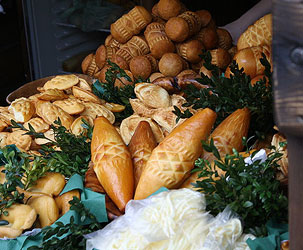
Twarog aka "white cheese" – traditionally Polish curd cheese
I'm a big fan of cheese. What makes it so attractive is that countless variety of tastes, genres and textures makes cheeses one of the largest groups of food products. The biggest producers of cheese are France, Switzerland and Holland - there's no doubt that these products taste delicious. Poland is obviously far behind, especially in the case of hard cheeses, but in history has also achieved some interesting products. There is about 4000 types of cheese in the world - 90 types are Polish.
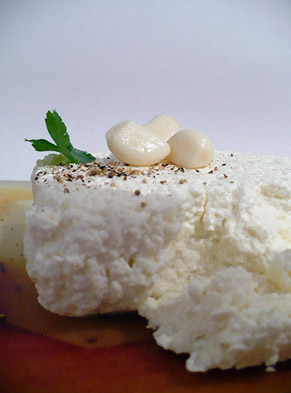
Traditional Polish cheese, called twaróg or tvarog, and also known as white cheese ('bialy ser' in Polish; sometimes also: ser twarogowy) is one of the most loved by Poles, and on the other hand, one of the most original. It is difficult to find exactly the same flavor anywhere else in the world. Although we usually translate Polish twarog into curd cheese, this is not the same curd cheese you may know. It does not taste similar to the popular cottage cheese either. Actually, in U.S. twarog is much more like what you call a 'farmer's cheese', than curd or cottage cheese.
Twarog has a special texture. At first glance you may think that it resembles common yellow cheese but after a closer look, it appears that this one is much more soft and juicy. The taste is in fact slightly tart, but that's the greatest charm of white cheese. Level of tart flavor depends of the preparation time (longer = more tart), since the milk is leavened and it got thick.
Polish twarog is made from cow milk, belongs to the so-called 'fresh' cheeses group. Unsurprisingly it has a white color, elastic consistency and lumpy structure. Just like with a Coke, Polish producers try to be up to date and offer few kinds of white cheese differing in fat content. Twarog cheese production is based on a so-called acidification of milk. Then, process involves gradual heating (without reaching the boiling point), and cooling followed by straining.
Most often twarog in Poland is sold in a form of little blocks, just like the one on the photo below. Twarog is cheap and the portion below, which weight is 200 g (0,44 lb), costs about 2,5 zloty (0.8-1$). 'Półtłusty' means that twarog has been partially skimmed. Fully skimmed twarog is called 'chudy' (thin), while non-skimmed natural one is labeled 'tłusty' (fat).
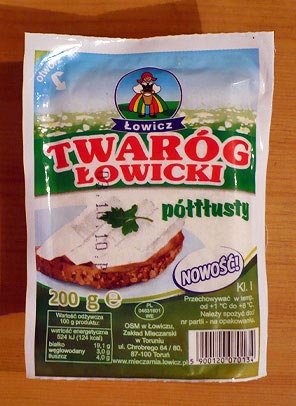
As usually in old cuisines, some traditional, basic foods and ingredients are omnipotent and quite universal. The same is with Polish white cheese, which is widely used as a basic ingredient of many Polish appetizers and simple foods.
Above all Polish twarog is used to prepare popular Polish appetizer called twarozek. All you need to do is to mix the cheese with sparseness of spices and some chopped vegetables - most often onion, radish, and/or cucumber. Generally speaking chives are also considered to be an essential element of twarozek - giving not only the taste, but also an aesthetic charm :) To facilitate mixing and to be sure that we get a uniform consistency a little bit of cream or yoghurt is usually added. You should season your snack with some salt and black pepper (or any other favorite spices), and be ready to gorge yourself with this great Polish food - directly from a bowl or after spreading on bread or a roll. Twarozek is one of quite popular Polish breakfasts - very straight food, easy to make (2-3 minutes), and not only tasty, but also healthy and nourishing. This is one of my breakfasts with twarozek, kabanosy, and black tea:
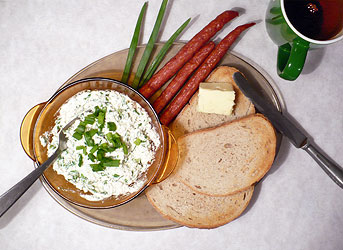
Twarog as a sweet ingredient in Polish cuisine
Another way of eating twarog is to make it sweet. This is absolutely not less important than spicy-vegetable twarozek! I tell you that with full responsibility - especially since I'm great sweets & desserts lover (see: list of Polish desserts & sweets) :) Hence, it is possible (and recommended:) to sweeten farmer's cheese to obtain a wonderful ingredient of one of some Polish desserts. The number of the combinations and applications is reasonable - let me describe three or four most notable.
The first thing, and probably most important one, is a sweetened white cheese as a basic element of Polish cheesecakes, called 'sernik' in Poland. I frankly recommend this dessert, if you would ever have an opportunity to try - do not hesitate. Usually vanilla sugar is used as an addition. Raisins are added too. Baking cheese in high temperature changes its structure and the taste more delicate (no tart aftertaste). Polish cheesecake is a real delicacy.
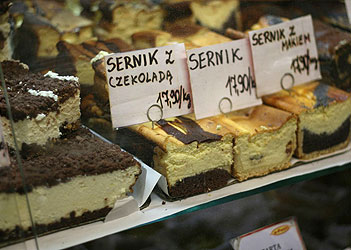
(photo by douglemoine)
Similar application is using twarog to make nalesniki (very popular in Poland) and sweet pierogi. Pierogi with sweet curd cheese are probably quite well known for most of you (of course there are also these spicy ones, with curd cheese, onion and potato filling, called ruthenian pierogi in Poland). Sweet cheese crepes are made analogously. Usually refried after filling with white cheese and poured with something tasty (e.g. fruit or chocolate sauce, or some sweet cream).
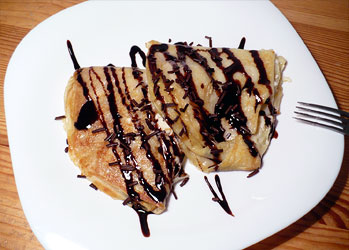
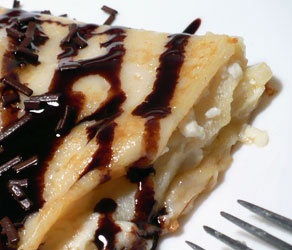
One other, completely simple way to make a dessert out from twarog is to simply sweeten it and use to make sandwiches. Put some favorite jam or powidl on it to make this simple food even more delicious:
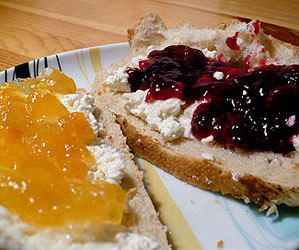
I won't be original now but have to add, that the same sweetened farmer's cheese can be served with pasta instead of bread. Poles call this dish 'kluski z serem'. On the picture below I have additionally used some brown sugar to sprinkle this food:
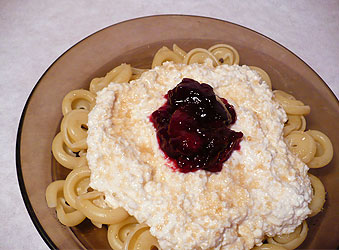
sprinkled with brown sugar and decorated with a morello cherry jam.
Eggs
What interesting can I write about eggs in Polish food recipes? Well, not much because in is respect the Polish cuisine does not differ from cuisines of other, European countries. Indeed Polish table won't shock you with something so unusual as Chinese Century egg. Hard and soft-boiled eggs, scrambled eggs and fried eggs are eaten. More unique is simple dessert made of raw yolk and sugar. It's called kogiel-mogiel or kogel-mogel. The dessert is known in Poland since 17th century (origins are probably Jewish). It became popular in the interwar period and in communist years when sweets weren't readily available. In Germany it is called Zuckerei, while in Russia - gogol-mogol. Apart from that eggs are of course one of basic elements of cakes. They are also an ingredient of coatings, creams, pancakes etc.
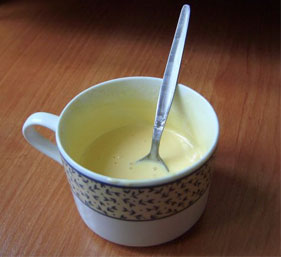
In Poland most oftentimes chicken, as well as duck's, goose's and quail eggs are eaten (lately a popularity of ostrich eggs grows).
Just like in many other countries a tradition of Easter eggs exists in Poland - these are known as 'pisanki'. As Wikipedia says:
"Many Slavic ethnic groups, including the Bulgarians (pisano yaytse), Croats (pisanica), Czechs (kraslice), Poles (pisanka), Serbs (pisanica), Slovaks (kraslica), Sorbs, Slovenes (pisanica or pirh), and Ukrainians (pysanka), decorate eggs for Easter. Many of the names derive from the Slavic root pisa which relates to writing. In Slavic tradition, the egg (similar to icons) is written, not drawn or painted. This is an Eastern European tradition, since Romanians, a Latin ethnic group, have it too." Wikipedia
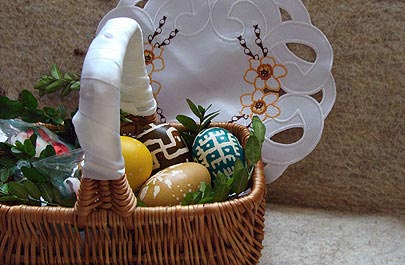
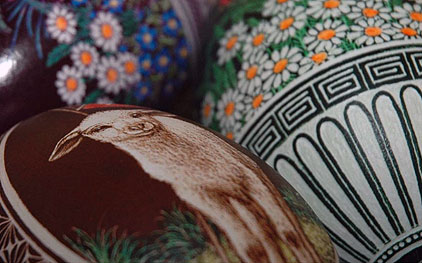
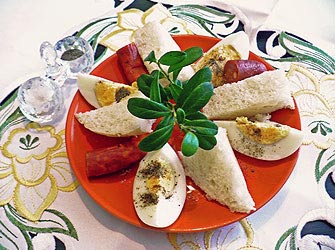
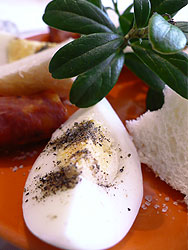
which are one of the most important traditions during Easter.